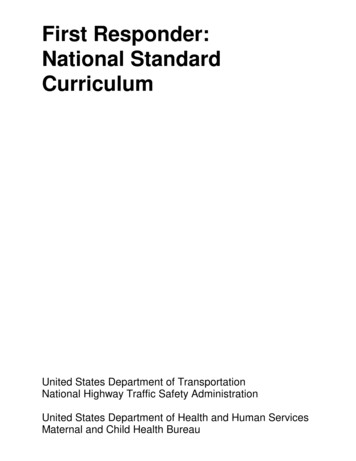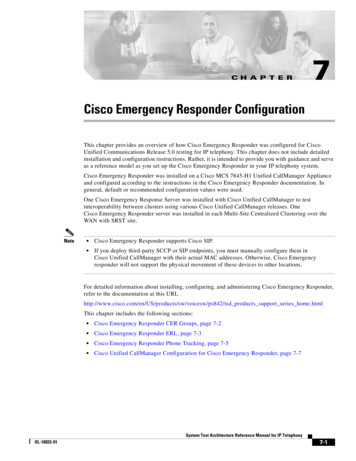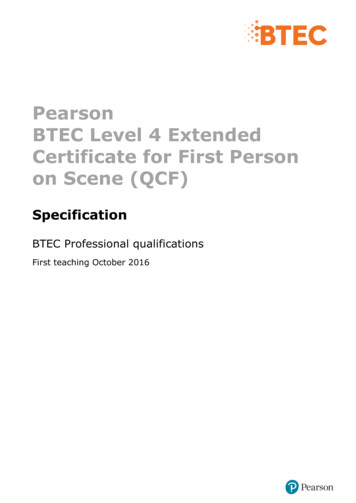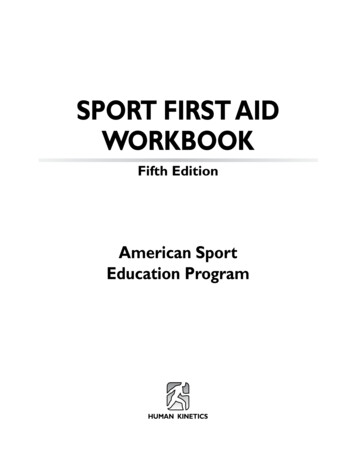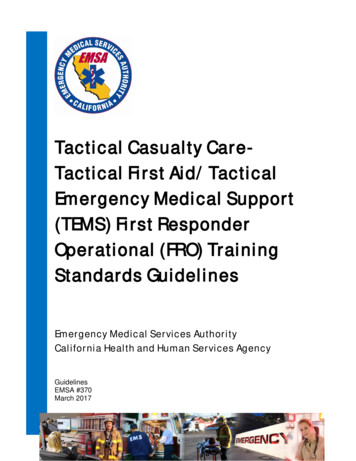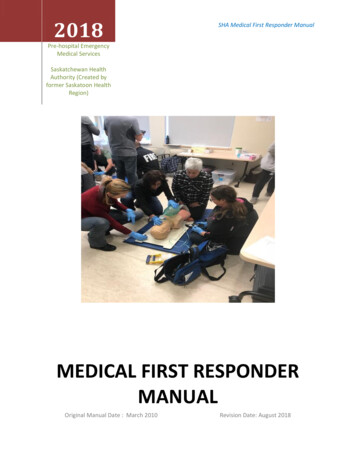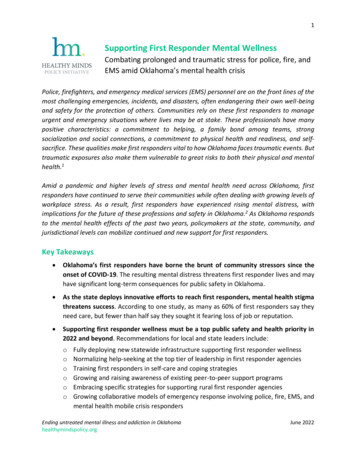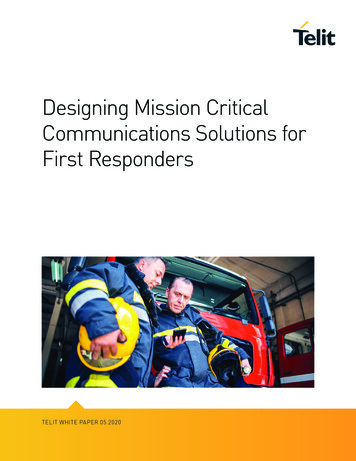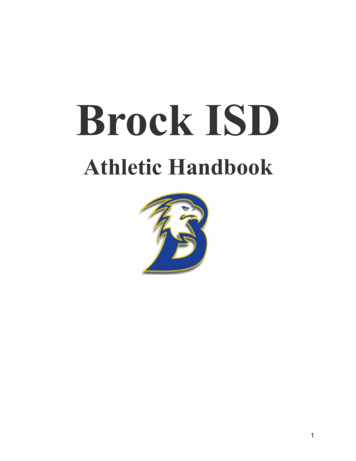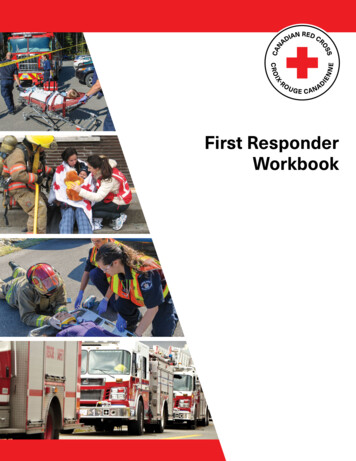
Transcription
First ResponderWorkbook
First ResponderWorkbook
Copyright 2020 The Canadian Red Cross SocietyAll rights reserved. No part of this publication may be reproduced, stored in a retrieval system, or transmitted, inany form or by any means—electronic, mechanical, photocopying, recording, or otherwise—without prior writtenpermission from The Canadian Red Cross Society.The Canadian Red Cross Society (CRCS) has made reasonable efforts to ensure the contents of this publicationare accurate and reflect the latest scientific research available on the topic as of the date published. Theinformation contained in this publication may change as new scientific research becomes available. Certaintechniques described in this publication are designed for use in lifesaving situations. However, the CRCScannot guarantee that the use of such techniques will prevent personal injury or loss of life.This publication is available in English and French.ISBN: 978-1-55104-847-520 21 22 23 24 / 5 4 3 2 1All brand names are included as examples only. The Canadian Red Cross Society does not endorse or recommendany specific brand or company.AcknowledgementsWe would like to recognize Graham Scott for his invaluable contributions to this revised workbook.
Table of ContentsThe Professional Responder.5Responding to the Call.8Infection Prevention and Control. 10Anatomy and Physiology. 13Assessment. 18Airway Management and Respiratory Emergencies. 23Circulatory Emergencies. 27Shock. 31Hemorrhage and Soft Tissue Trauma. 33Musculoskeletal Injuries. 37Chest, Abdominal, and Pelvic Injuries. 40Head and Spinal Injuries. 43Acute and Chronic Illnesses. 45Poisoning. 48Environmental Illnesses. 51Pregnancy, Labour, and Delivery. 54Special Populations. 57Crisis Intervention. 61Reaching, Lifting, and Extricating Patients. 63Transportation. 66Multiple-Casualty Incidents. 68Pharmacology . 72First Responder WorkbookCopyright 2020 The Canadian Red Cross Society 4
The Professional ResponderFor Your ReviewRead Chapter 1 of Emergency Care for Professional Responders, then complete the following activities.Key TermsReferring to Emergency Care for Professional Responders, define the following terms:Abandonment:Confidentiality:Consent:Critical Incident Stress (CIS):Duty to act:Emergency medical responder (EMR):Emergency medical services (EMS) system:First responder:Good Samaritan laws:Interpersonal communication:Medical terminology:Negligence:Offline medical control:Online medical control:First Responder WorkbookCopyright 2020 The Canadian Red Cross SocietyThe Professional Responder 5
Post-Traumatic Stress Disorder (PTSD):Refusal of care:Standard of care:What Would You Do?Read the following scenario and answer thequestions below.While you are driving to work one morning, you seethat someone has fallen off his bicycle and seems tobe bleeding from his leg quite severely. As you getcloser, you notice that the bike is badly damaged, andthe person has cuts and scrapes all over him.1. In this situation, do you have a duty to act? If so,why? If not, why not?Test Your Knowledge1. Which of these is not a level recognized by theParamedic Association of Canada?a. Primary Care Paramedicb. Initial Care Paramedicc. Critical Care Paramedicd. Emergency Medical Responder2. List six signs and symptoms of critical incidentstress:i.ii.2. If you do act in this situation, your first concernshould be to:a. Bandage the woundsb. Determine whether there are any otherinjuries you can’t seec. Ensure your safety and the safety of anybystandersd. Call work and tell them you will be late3. What types of hazards may be present? Whatcan you do to protect yourself from these?iii.iv.v.vi.3. When obtaining consent before caring forsomeone, which of the following do you NOThave to do?a. Have the person sign an Acceptance ofTreatment formb. Identify yourself with your namec. Indicate what you think may be wrong andwhat you plan to dod. State your level of training4. List three elements of good documentation:i.ii.iii.First Responder WorkbookCopyright 2020 The Canadian Red Cross SocietyThe Professional Responder 6
5. Discontinuing care of a patient without theirconsent, or without ensuring that someone withequal or greater training will continue the care,is called:a. Abandonmentb. Refusal of carec. Transfer of functiond. Competence6. Identify whether each of the followingstatements about critical incident stress (CIS) istrue or false:i. The signs and symptoms of CIS usuallyappear soon after the event.T orFii. The signs and symptoms of CIS usually lastmuch longer than those of PTSD.T orFiii. You should try to deal with stressfulsituations on your own before turning toprofessional mental health services.T orFiv. Signs and symptoms of CIS can includeconfusion, anger, and increased ordecreased appetite.T orFv. CIS can be caused by any emergencyresponse, regardless of the circumstances.T orF7. Identify three components of a radio system:i.ii.iii.8. If you are speaking with a physician, it isimportant that you:a. Write down everything the physician saysb. Repeat any orders back to the physicianc. Present all information rapidlyd. Verify that everything said by the physician iscovered in your written protocols9. Which of the following is good practice whenusing a radio?a. Speaking slowly and clearlyb. Beginning to speak at the same time youpush the “push to talk” buttonc. Holding the radio right up to your mouthd. Relaying all information you have collected atthe scene up to that point10. List three elements of self-care:i.ii.iii.First Responder WorkbookCopyright 2020 The Canadian Red Cross SocietyThe Professional Responder 7
Responding to the CallFor Your ReviewRead Chapter 2 of Emergency Care for Professional Responders, then complete the following activities.Key TermsReferring to Emergency Care for Professional Responders, define the following terms:Hazardous materials:What Would You Do?Read the following scenario and answer thequestions below.You arrive at the scene of a motor vehicle collision.One car is perched on its side and on the other sideof the road a truck has hit a large tree, snapping thetrunk and leaving the tree angled over the truck.1. As you approach the scene, you see a placard onthe truck indicating that a flammable substanceis on board. Which of the following would be anappropriate action to take?a. Opening the truck’s doors and investigatingwhat the substance isb. Ensuring that personnel who haveappropriate training to deal with hazardousmaterials have been notifiedc. Having bystanders gather buckets of water incase of fired. Checking to see if any houses nearby have achainsaw so you can cut down the tree2. Appropriate resources are on the scene, dealingwith the truck and directing traffic. You are clearto begin necessary treatment. The truck driverappears uninjured. He exits the truck underhis own power and another responder tends tohim. You now make your way to the car and itspassengers. What should be your first step?a. Climbing into the car to assess the peopleinsideb. Asking the people in the car to climb outc. Ensuring that the car has been stabilized andis safed. Gathering people to help you roll the caruprightFirst Responder WorkbookCopyright 2020 The Canadian Red Cross SocietyTest Your Knowledge1. Which of the following is NOT a primaryresponsibility of the responder at an emergencyscene?a. Ensuring safety for yourself and anybystandersb. Gaining access to the patient(s)c. Contacting the friends and/or family of thepatientd. Determining any threats to the patient’s life2. If there is a downed electrical wire at anemergency scene, how far away should anybystanders be?a. Twice the length of the span of the wireb. Half the distance between the two polesfrom which the broken wire has been strungc. At least 15 metres (50 feet) from the downedwired. There is no specific distance that is safe3. Which of the following is a clue that a hazardousmaterial may be present at an emergency?a. Chemical transport tanks and/or placardsb. Clouds of vapour or spilled solids or liquidsc. Unusual odoursd. All of the above4. Identify whether each of the followingstatements about emergency response plans istrue or false:i. They should be created as soon as you arriveat the scene of the emergency.T orFii. They require you to be aware of the speciallytrained personnel in your community andhow to contact them.T orFResponding to the Call 8
iii. They can apply to specific buildings or tolarger areas.T orFiv. Once established, they must be practicedregularly.T orFv. They should be kept confidential and notcirculated outside of your agency.T orF5. Identify one strategy you should use if youencounter each of the following emergencyscenes:7. When is it acceptable to enter a confined spaceto help a patient?a. When you must access a patient to performimmediate life-saving interventionsb. When there are no other responders on thescenec. When you have specialized training indealing with confined spacesd. When you have confirmed that the confinedspace has adequate ventilation systemsoperatingDrug Labs:Hostage Situations:Crime Scenes:6. Each Safety Data Sheet (SDS) breaks downinformation about a given substance into 16categories. Name four of those categories.i.ii.iii.iv.First Responder WorkbookCopyright 2020 The Canadian Red Cross SocietyResponding to the Call 9
Infection Prevention and ControlFor Your ReviewRead Chapter 3 of Emergency Care for Professional Responders, then complete the following activities.Key TermsReferring to Emergency Care for Professional Responders, define the following terms:Acquired immune deficiency syndrome (AIDS):Airborne transmission:Bacteria:Blood-borne pathogens:Community-associated MRSA:Direct contact transmission:Hepatitis:Herpes:Human immunodeficiency virus (HIV):Immune system:Immunization:Indirect contact transmission:Infection:Infectious disease:First Responder WorkbookCopyright 2020 The Canadian Red Cross SocietyInfection Prevention and Control 10
Influenza:Meningitis:Pathogen:Severe acute respiratory syndrome (SARS):Tuberculosis:Vector-borne transmission:Virus:What Would You Do?Read the following scenario and answer thequestions below.You are called to an office because a young intern isworried about her boss, who has fallen and cut hisleg. Upon talking to her, you learn that her boss hasbeen coughing more than usual, and at times therehas been blood on the tissues he uses. She attributedthis to his age. As you approach him, he is coughing.1. What personal protective equipment, if any,should you wear when caring for the patient?Test Your Knowledge1. Which of the following can be transmitted byairborne particles?a. HIV/AIDSb. Hepatitis and chicken poxc. Meningitis and tuberculosisd. Herpes and tetanus2. The four conditions that must be present for aninfection to be transmitted to someone are:i.ii.2. Aside from the cut on his leg, what ailmentmight the patient be suffering from?a. Meningitisb. Tuberculosisc. Kidney stonesd. Chickenpox/shinglesiii.iv.3. If the patient’s intern became infected throughparticles expelled during coughing, whatmethod of disease transmission would this be?a. Direct contactb. Indirect contactc. Vector-borne transmissiond. Airborne transmissionFirst Responder WorkbookCopyright 2020 The Canadian Red Cross SocietyInfection Prevention and Control 11
3. List four precautions you can take to preventdisease transmission:i.ii.iii.iv.4. An exposure control plan should include thefollowing elements:i.6. In which of the following cases should you wearfull protective equipment (gloves, gown, mask,and eyewear)?a. When wiping down a blood pressure cuffafter a callb. When caring for bleeding that is spurtingc. When caring for someone with signs of aninfectious respiratory illnessd. Both b and c7. Which of the following can be transmitted bycontaminated food?a. Tuberculosis and rubellab. Typhus and diphtheriac. Meningitis and hepatitis Ad. HIV/AIDS and herpes8. For each of the diseases in the table below,identify the mode(s) of transmission andwhether a vaccination exists.Diseaseii.Mode(s) ofTransmissionVaccinationMeningitisHepatitis Aiii.Hepatitis CTuberculosisiv.Influenza5. If you think you have been exposed to aninfectious disease at an emergency scene, thefirst step you should take is:a. Go to a hospital to be testedb. Report the exposure immediatelyc. Determine what type of disease it isd. Contact the Poison Control CentreFirst Responder WorkbookCopyright 2020 The Canadian Red Cross SocietyHIV/AIDSInfection Prevention and Control 12
Anatomy and PhysiologyFor Your ReviewRead Chapter 4 of Emergency Care for Professional Responders, then complete the following activities.Key TermsReferring to Emergency Care for Professional Responders, define the following terms:Anatomical Position:Body system:Cell:Circulatory system:Digestive system:Endocrine system:Genitourinary system:Integumentary system:Ligament:Musculoskeletal system:Nervous system:Respiratory system:Tendon:Vital organs:First Responder WorkbookCopyright 2020 The Canadian Red Cross SocietyInfection Prevention and Control 13
What Would You Do?Body CavitiesRead the following scenario and answer thequestions below.While at work at a machine shop, a man is turninga piece of steel on a lathe. The chuck is not tightenough, and when the tool makes contact with thesteel, the steel projects itself toward the man. Heputs his arm up to block his face and the steel makesa deep laceration in the back of his upper arm.1. Using correct terminology, describe the locationof the injury in relation to these other bodystructures:i. Elbow:ii. Shoulder:2. Is the injury superior or inferior to the pelvis?3. Which two body systems will interact to alert theman to his injury?a. Nervous and respiratoryb. Endocrine and nervousc. Nervous and integumentaryd. Circulatory and digestiveRespiratory SystemTest Your Knowledge1. Fill in the blanks with the correct body parts andother terminology below.Directional TermsFirst Responder WorkbookCopyright 2020 The Canadian Red Cross SocietyAnatomy and Physiology 14
Circulatory SystemFirst Responder WorkbookCopyright 2020 The Canadian Red Cross Society2. On the diagram below, indicate the location ofthe following structures: femur, pelvis, humerus,clavicle, skull, patella, radius, scapula, sternum,tibia, ulna, cranium, face, ribs, spinal column,coccyx, thorax, fibula.Anatomy and Physiology 15
3. Complete the chart by filling in the empty cells:Body SystemMajor ComponentsPurposeSupplies the body with oxygenthrough breathing.Bones, muscles, joints, ligaments,tendonsNervousBreaks down food and eliminateswasteIntegumentaryHeart, arteries, veins, capillaries,blood4. Epinephrine opens the airway by constrictingthe blood vessels (reducing swelling) andincreasing the heart rate. Which two bodysystems does this indicate that epinephrineaffects?i.ii.5. The epiglottis prevents liquids and solids fromentering what?a. The stomachb. The lungsc. The sinusesd. The intestinesFirst Responder WorkbookCopyright 2020 The Canadian Red Cross Society6. Where do arteries carry blood?a. From the heart to the body tissuesb. From the lungs to the heartc. From the heart to the lungsd. Both a and c7. One of the main functions of the integumentarysystem is to:a. Prevent infectionb. Secrete hormonesc. Produce white blood cellsd. Transport nutrients to cellsAnatomy and Physiology 16
8. In comparison with the chest, the neck isdescribed as, whereas theabdomen is described as.a. Medial, lateralb. Superior, inferiorc. Proximal, distald. Anterior, posterior9. The respiratory system and cardiovascularsystem work together to:a. Provide oxygen to the cells of the bodyb. Keep hormones distributed throughout thebodyc. Regenerate nervous tissue after injuryd. Regulate blood flow to the digestive system10. Complete the chart by identifying the bodysystem that each component is part of:ComponentBody SystemTracheaAV nodeFibulaSpinal cordAortaSacrumDeltoidDermisLymphatic ductPancreasPatellaFirst Responder WorkbookCopyright 2020 The Canadian Red Cross SocietyAnatomy and Physiology 17
AssessmentFor Your ReviewRead Chapter 5 of Emergency Care for Professional Responders, then complete the following activities.Key TermsReferring to Emergency Care for Professional Responders, define the following terms:Blood pressure (BP):Brachial artery:Carotid arteries:Chief complaint:Cyanosis:Glasgow Coma Scale (GCS):Glucometry:Golden Hour:Head-tilt/chin-lift:Jaw thrust:Level of responsiveness:Mechanism of injury (MOI):Primary assessment:Pulse oximetry:First Responder WorkbookCopyright 2020 The Canadian Red Cross SocietyAnatomy and Physiology 18
Rapid body survey:Rapid transport category:Respiratory rate:Secondary assessment:Spinal Motion Restriction:Transport decision:Vital signs:What Would You Do?Read the following scenario and answer thequestions below.You are called to the local park, where a five-year-oldchild has collapsed in the sandbox. The child is notresponsive. You confirm that the child is breathingeffectively and has a carotid pulse.1. What are the next three steps you should take?i.ii.iii.2. You assess the patient’s vital signs and find thefollowing. Put an “X” next to any vital signs thatsuggest a potential problem.Vital SignNormal vs. NotNormalVital SignNormal vs. NotNormalSkin: Pale, cool, andclammyBlood pressure: 120/60Pupils: Equal, round,and reactive to light3. The child’s babysitter is able to answer anyquestions you have regarding the child. Which ofthe following should you ask her about?a. The child’s sleeping patterns, eating times,and vaccination recordsb. The events leading up to the collapse, aswell as the child’s allergies, medical history,current medications, and last oral intakec. The child’s age, address, and schoold. The child’s normal vital signs (e.g. respiratoryrate, temperature) and typical behaviourLevel of responsiveness:UnresponsiveBreathing: 10, shallow,and regularPulse: 100, strong, andregularFirst Responder WorkbookCopyright 2020 The Canadian Red Cross SocietyAssessment 19
4. After completing your secondary assessment,you perform another vital signs check andobserve the following. Put an “X” next to anyvital signs that suggest a potential problem.Vital Sign2. Label the pulse sites in the diagram:Normal vs. NotNormalLevel of responsiveness:Reactive to verbalstimuliBreathing: 14, strong,and regularPulse: 100, strong, andregularSkin: Warm and pinkBlood pressure: 110/60Pupils: Equal, round,and reactive to lightTest Your Knowledge1. Fill in the boxes to show the steps in theassessment process in order:3. Complete the words or phrases represented byeach mnemonic below.ABCABCSAMPLESAMPLEAVPUAVPUFirst Responder WorkbookCopyright 2020 The Canadian Red Cross SocietyAssessment 20
OPQRST6. Which of the following should you treat beforeperforming a secondary assessment?a. A fracture of the elbowb. An impaled object in the right handc. Severe bleeding from the left legd. None of these injuries should be treated untilafter the secondary assessmentOPQRST4. Fill in the name of the vital sign that correspondsto each observation in the table below.ObservationVital Sign120/72Alert and orientedEqual, round, andreactive to light14, regular, and deepDilated and fixed76, regular, and strong93, weak, and irregular130/PPale, cool, and clammyGCS of 13Red, hot, and dryUnresponsive5. If you check capillary refill and the nail bed doesnot return to its normal colour after you release,what does this mean?a. The patient has insufficient circulationb. You pressed on the fingernail too hardc. You did not press on the fingernail hardenoughd. The patient’s heart is not beatingFirst Responder WorkbookCopyright 2020 The Canadian Red Cross Society7. When forming a general impression, which ofthe following do you NOT need to determine?a. Whether the patient is ill or injuredb. The patient’s sex and approximate agec. Whether the patient takes any medicationsd. The patient’s chief complaint or problem8. Which of the following patients should be in therapid transport category?a. A 30-year-old woman who has a bruise onher leg from a soccer ballb. A 50-year-old man experiencing numbnessand tingling on the right side of his body, andslurred speechc. A 10-year-old girl who is crying because of abee stingd. A 65-year-old man experiencing stiffness inhis back after swimming 30 lengths of thepool9. What are the purposes of the primary andsecondary assessments?a. Determine whether the patient is in shock;identify whether the patient is still in shock orif your treatment has helpedb. Identify any hazards that are a threat to thoseat the scene; determine what else might bewrong with the patientc. Determine the initial vital signs to comparewith during later monitoring; identify anyallergies or medications the patient mighthaved. Identify conditions that are an immediatethreat to life or could become an immediatethreat to life; identify conditions that are notimmediately life-threatening10. What are the three parts of the secondaryassessment?i.ii.iii.Assessment 21
11. List three pieces of equipment you might use tocheck a patient’s vital signs:i.ii.iii.First Responder WorkbookCopyright 2020 The Canadian Red Cross SocietyAssessment 22
Airway Management and Respiratory EmergenciesFor Your ReviewRead Chapter 6 of Emergency Care for Professional Responders, then complete the following activities.Key TermsReferring to Emergency Care for Professional Responders, define the following terms:Airway obstruction:Anaphylaxis:Assisted ventilation:Aspiration:Asthma:Bradypnea:Chronic bronchitis:Chronic obstructive pulmonary disease (COPD):Dyspnea:Emphysema:Epinephrine:Finger sweep:Hyperventilation:Hypoxia:First Responder WorkbookCopyright 2020 The Canadian Red Cross SocietyAssessment 23
Metered-dose inhaler (MDI):Pneumonia:Respiratory arrest:Tachypnea:What Would You Do?Read the following scenarios and answer thequestions below.Scenario 1You are called to a break room where someone ischoking. More advanced care is on the way. Youarrive to find that the choking person has goneinto the washroom to avoid embarrassment. Thewoman is visibly pregnant and quite far along. She islooking pale and anxious and is making high-pitchedwheezing sounds.1. After identifying yourself and explaining whatyou are going to do, you should:a. Have the patient lie on the ground and beginchest compressionsb. Stand behind the patient and beginabdominal thrustsc. Do nothing until the patient stops makingsoundsd. Stand behind the patient and alternatebetween five firm back blows and five chestthrusts2. The woman becomes unresponsive, and youlower her safely to the ground. You open herairway using a head-tilt/chin-lift and checkfor breathing and a pulse. You find she is notbreathing but has a pulse. You should:a. Attempt to give her a ventilationb. Check for bystanders who can answerSAMPLE questionsc. Begin chest compressionsd. Do a finger sweep of her mouthFirst Responder WorkbookCopyright 2020 The Canadian Red Cross Society3. At one point, your ventilation goes in and yousee the patient’s chest just begin to rise. Youshould:a. Do 30 chest compressionsb. Give another ventilationc. Roll the patient into the recovery positiond. Recheck the patient’s ABCs4. If you find that the woman is not breathingbut still has a pulse, you should give her oneventilation every five to six seconds.T orFScenario 2You are called to a cafeteria where a patient in hismid-twenties is having a severe allergic reaction. Hehas a MedicAlert medical identification productaround his neck that indicates he has a severeallergy to peanuts, and he has used his prescribedepinephrine auto-injector. The person sitting besidehim in the cafeteria was eating a granola bar.1. Which body systems can be affected byanaphylaxis?a. Nervous, endocrine, and genitourinaryb. Integumentary, endocrine, musculoskeletal,and nervousc. Digestive, respiratory, and genitourinaryd. Integumentary, respiratory, cardiovascular,and digestive2. Hives or redness may be the visual signs ofanaphylaxis on the skin. What signs may bepresent that indicate an effect on the digestivesystem?Airway Management and Respiratory Emergencies 24
Test Your Knowledge1. Identify the condition that corresponds to eachdescription in the table below.ConditionDescriptionAn obstruction in theairwayA narrowing of the airpassagesA disease in whichcarbon dioxide/oxygenexchange is noteffectiveA swelling of the airpassages due to areaction to an allergenA disease causingexcessive mucoussecretions and antiinflammatory changesto the bronchiBreathing faster thannormal2. A person has experienced anaphylacticreactions in the past will often carry:a. A glucometerb. An epinephrine auto-injectorc. A pulse oximeterd. A metered-dose inhaler3. General care for any respiratory distress caninclude:a. Assisting the patient with taking prescribedmedication, reassuring the patientb. Performing CPRc. Having the patient lie down, keeping thepatient coold. Ensuring the area is well-ventilated,performing abdominal thrusts4. A patient has no signs of breathing orcirculation. After giving two one-secondventilations, what should you do?a. Check for signs of circulation, including apulse, for no more than 5 to 10 secondsb. Check the patient’s level of responsivenessc. Continue providing assisted ventilationd. Begin 30 chest compressionsFirst Responder WorkbookCopyright 2020 The Canadian Red Cross Society5. If an unresponsive patient vomits while youare performing ventilations, this is probablybecause:a. The smell of the mask is bothering thepatientb. The head wasn’t tilted back appropriately, oryou were ventilating too forcefullyc. The patient had been poisoned and theventilations caused the stomach to expel thepoisond. The lungs are reacting to the positivepressure of the ventilations6. If a patient is wearing dentures and you need
much longer than those of PTSD. T or F iii. You should try to deal with stressful situations on your own before turning to professional mental health services. T or F iv. Signs and symptoms of CIS can include confusion, anger, and increased or decreased appetite. T or F v. CIS can be caused by any emergency
